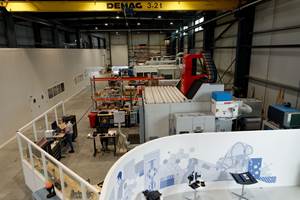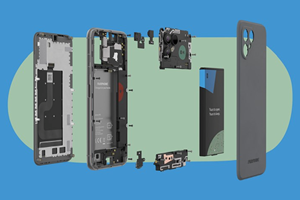Other Applications Expand
A growing area in the offshore world is the refitting or “recycling” of older oil platforms to support additional production. A particularly active area for recycling is in the North Sea, where additional pipelines can be run to existing rigs for about $1 million (as opposed to spending $20 million for a new r
A growing area in the offshore world is the refitting or “recycling” of older oil platforms to support additional production. A particularly active area for recycling is in the North Sea, where additional pipelines can be run to existing rigs for about $1 million (as opposed to spending $20 million for a new rig). However, fire safety regulations have changed in the last 15 years. Today, before an old rig can be updated for modern use, all the fire safety cases must be reviewed, often resulting in a requirement for substantial amounts of new fireproofing. Typically, the existing structural steelwork on older rigs was not designed to take on significant extra weight. Composites enable upgrades with minimum additional weight.
Alderley Materials’ Reichelt believes that his company has completed the first in situ, in-service fire proofing of an old riser system on the Snorre B, 30 miles off the coast of Norway. It is one of a number of interlinked rigs in an area where a lot of drilling is still going on, even as old fields are beginning to shut down. Reichelt anticipates that recycling oil rigs “will become a significant area of business” for Alderley.
FRP products are attractive for retrofit applications because they are easy to handle and can be installed using pneumatic tools. Since FRP does not require welding, production need not be shut down while enhancements are installed.
Mech-Tool Engineering Ltd.’s (Darlington, U.K.) composites division, headed by David Beardsworth, specializes in fire and blast protection for personnel and buildings, using phenolic, vinyl ester and polyester resins with glass, aramid and carbon fiber reinforcements. The company recently provided three blast-relief systems and one heat-shielding system for four major North Sea projects.
The blast-relief system consisted of composite sandwich panels roughly the size of a standard door (78.8-inches by 39.4-inches by 1.625-inches/2m by 1m by 40-mm), constructed with PVC cores and aramid/vinyl ester skins. The panels were installed on hinges secured with relief pins, as part of the deck. “In the event of an explosion,” Beardsworth explains, “the pins release and the panels open outwards, thus relieving the pressure and preventing damage to the primary structure.” The composite panels blow out more easily than steel panels, making it easier to channel the blast down a prearranged path so it vents safely. The heat shielding system consisted of phenolic cores with a borosilicate filler, covered by fiberglass/phenolic skins. The panels passed the H60 and H120 fire tests, although this particular application only called for heat shielding.
Alderley Materials has developed valve protection boxes to protect emergency shutdown valves during a fire- fighting emergency. Its recently introduced, bolt-together box system is designed to be removable, thus providing access to the manways. The fiberglass/phenolic boxes also provide mechanical and thermal protection during the hour or more it might take workers to shut down required systems and evacuate a rig in a crisis. These boxes are currently in use on the Terranova, built in Newfoundland. The Girassol, now under construction in South Korea, will use 62 valve-protection boxes up to 4-ft by 4-ft by 8-ft/1.2-m by 1.2-m by 2.5-m in size.
Another firm, Jo Bird & Company Ltd. (Somerset, U.K.), produces FRP and polyethylene molded storage cabinets for firefighting equipment, respirators and safety apparatus. The durable cabinets feature a flame- retardant resin construction and are Lloyd’s Register-approved.
Currently, fiberglass living quarters can be installed on fixed (not floating) platforms, which are regulated by the Mineral Management Service (MMS) in the Gulf of Mexico. Floating vessels and platforms are regulated by the USCG and require an A60 fire rating for sleeping quarters, a requirement designed for 0.25 inch/6.5 mm steel. Fiberglass Unlimited Inc. (Raceland, La., U.S.A.) provides fiberglass housing modules for fixed platforms throughout the Gulf of Mexico, supplying anything from a relatively small “fourpack” office/galley/sleeping module to a complete 46-man heliport/quarters complex. The buildings can be made of wood that is laminated with continuous woven glass and isophthalic polyester fire-retardant resin and topped with a gel coat, or they can be an all-composite construction, with sandwich panel walls formed by extruded skins filled with a polyurethane foam. Modules can be transported on typical offshore supply boats and erected with the existing platform crane. If space is tight, temporary modules can be constructed on top of the permanent living quarters or heliport, and a temporary heliport (also of wood/fiberglass construction) can be placed on top of the temporary units. The heliport design accommodates a Bell 212 type helicopter. Modules are most commonly rented as housing for workover teams and go with the teams when they move on to another platform.
Related Content
JEC World 2023 highlights: Recyclable resins, renewable energy solutions, award-winning automotive
CW technical editor Hannah Mason recaps some of the technology on display at JEC World, including natural, bio-based or recyclable materials solutions, innovative automotive and renewable energy components and more.
Read MoreNovel composite technology replaces welded joints in tubular structures
The Tree Composites TC-joint replaces traditional welding in jacket foundations for offshore wind turbine generator applications, advancing the world’s quest for fast, sustainable energy deployment.
Read MorePlant tour: Daher Shap’in TechCenter and composites production plant, Saint-Aignan-de-Grandlieu, France
Co-located R&D and production advance OOA thermosets, thermoplastics, welding, recycling and digital technologies for faster processing and certification of lighter, more sustainable composites.
Read MoreComposites end markets: Electronics (2024)
Increasingly, prototype and production-ready smart devices featuring thermoplastic composite cases and other components provide lightweight, optimized sustainable alternatives to metal.
Read MoreRead Next
VIDEO: High-volume processing for fiberglass components
Cannon Ergos, a company specializing in high-ton presses and equipment for composites fabrication and plastics processing, displayed automotive and industrial components at CAMX 2024.
Read MoreDeveloping bonded composite repair for ships, offshore units
Bureau Veritas and industry partners issue guidelines and pave the way for certification via StrengthBond Offshore project.
Read More





















